Health Promotion Strategy: Reducing Alcohol Consumption in Australia
VerifiedAdded on 2022/12/26
|8
|1632
|38
Report
AI Summary
This report examines a health promotion strategy focused on alcohol consumption in Australia, addressing a key assignment topic within the context of public health. It begins with an introduction to the historical consumption patterns of alcohol in Australia, highlighting the shift from spirits to current trends, and the government's role in monitoring and addressing alcohol-related harms. The report discusses the National Drug Strategy, outlining its principles of demand reduction, supply reduction, and harm reduction, and analyzes the factors that influence drinking patterns including age, gender, culture, and socioeconomic status. It identifies the target population as young adolescents and considers factors inhibiting their understanding and access to strategies, such as lack of awareness and peer pressure. The report proposes intervention strategies including enhancing knowledge, facilitating planning, exploring price mechanisms, and early intervention in schools. It also covers community engagement, awareness programs, and approaches to reduce adverse health, social, and economic consequences. The report concludes by emphasizing the adverse effects of alcohol consumption and the strategies implemented by the Australian Government Department of Health to mitigate risks.

Running head: HEALTH PROMOTION STRATEGY
HEALTH PROMOTION STRATEGY
Name of the student
Name of the university
Author’s name
HEALTH PROMOTION STRATEGY
Name of the student
Name of the university
Author’s name
Paraphrase This Document
Need a fresh take? Get an instant paraphrase of this document with our AI Paraphraser
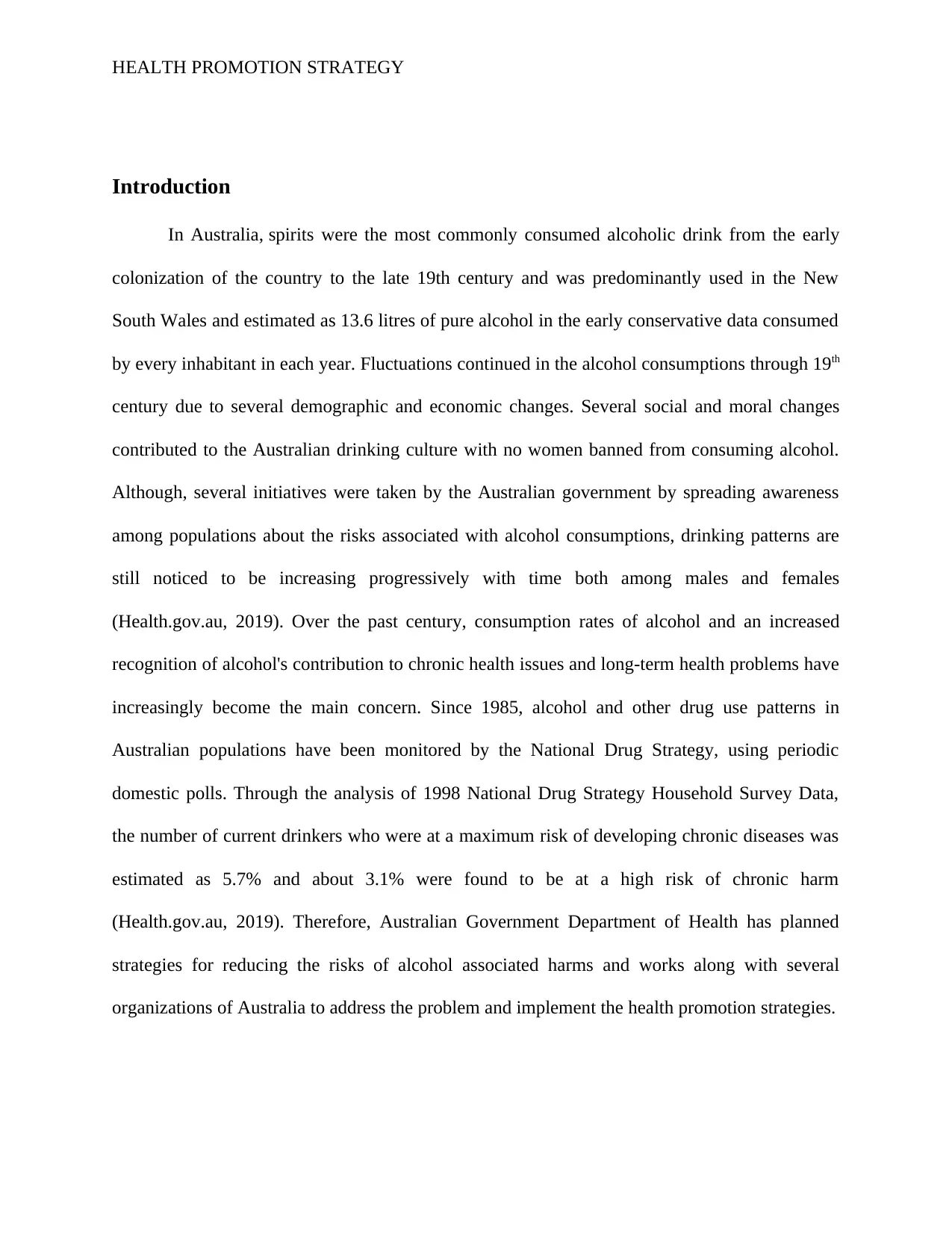
HEALTH PROMOTION STRATEGY
Introduction
In Australia, spirits were the most commonly consumed alcoholic drink from the early
colonization of the country to the late 19th century and was predominantly used in the New
South Wales and estimated as 13.6 litres of pure alcohol in the early conservative data consumed
by every inhabitant in each year. Fluctuations continued in the alcohol consumptions through 19th
century due to several demographic and economic changes. Several social and moral changes
contributed to the Australian drinking culture with no women banned from consuming alcohol.
Although, several initiatives were taken by the Australian government by spreading awareness
among populations about the risks associated with alcohol consumptions, drinking patterns are
still noticed to be increasing progressively with time both among males and females
(Health.gov.au, 2019). Over the past century, consumption rates of alcohol and an increased
recognition of alcohol's contribution to chronic health issues and long-term health problems have
increasingly become the main concern. Since 1985, alcohol and other drug use patterns in
Australian populations have been monitored by the National Drug Strategy, using periodic
domestic polls. Through the analysis of 1998 National Drug Strategy Household Survey Data,
the number of current drinkers who were at a maximum risk of developing chronic diseases was
estimated as 5.7% and about 3.1% were found to be at a high risk of chronic harm
(Health.gov.au, 2019). Therefore, Australian Government Department of Health has planned
strategies for reducing the risks of alcohol associated harms and works along with several
organizations of Australia to address the problem and implement the health promotion strategies.
Introduction
In Australia, spirits were the most commonly consumed alcoholic drink from the early
colonization of the country to the late 19th century and was predominantly used in the New
South Wales and estimated as 13.6 litres of pure alcohol in the early conservative data consumed
by every inhabitant in each year. Fluctuations continued in the alcohol consumptions through 19th
century due to several demographic and economic changes. Several social and moral changes
contributed to the Australian drinking culture with no women banned from consuming alcohol.
Although, several initiatives were taken by the Australian government by spreading awareness
among populations about the risks associated with alcohol consumptions, drinking patterns are
still noticed to be increasing progressively with time both among males and females
(Health.gov.au, 2019). Over the past century, consumption rates of alcohol and an increased
recognition of alcohol's contribution to chronic health issues and long-term health problems have
increasingly become the main concern. Since 1985, alcohol and other drug use patterns in
Australian populations have been monitored by the National Drug Strategy, using periodic
domestic polls. Through the analysis of 1998 National Drug Strategy Household Survey Data,
the number of current drinkers who were at a maximum risk of developing chronic diseases was
estimated as 5.7% and about 3.1% were found to be at a high risk of chronic harm
(Health.gov.au, 2019). Therefore, Australian Government Department of Health has planned
strategies for reducing the risks of alcohol associated harms and works along with several
organizations of Australia to address the problem and implement the health promotion strategies.
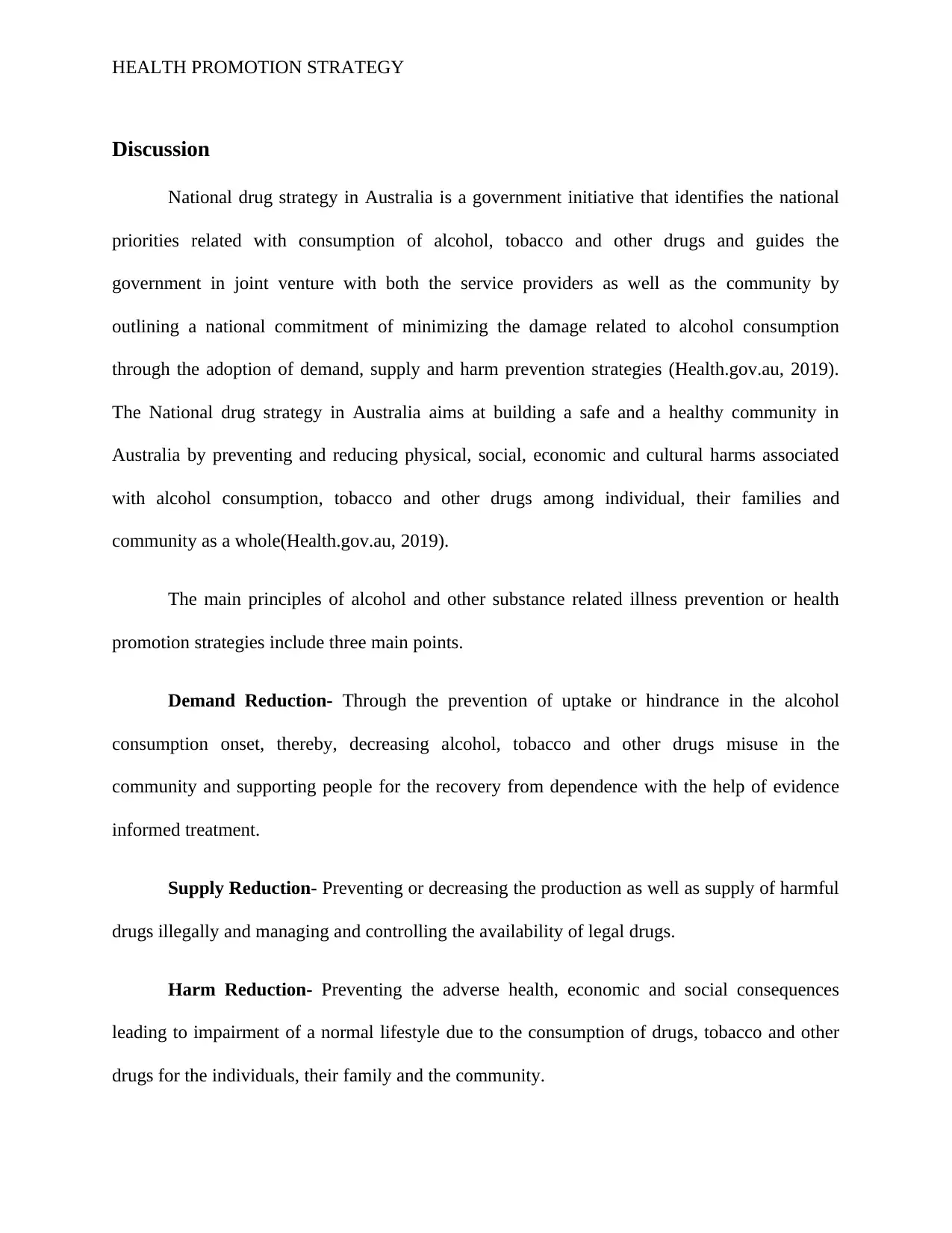
HEALTH PROMOTION STRATEGY
Discussion
National drug strategy in Australia is a government initiative that identifies the national
priorities related with consumption of alcohol, tobacco and other drugs and guides the
government in joint venture with both the service providers as well as the community by
outlining a national commitment of minimizing the damage related to alcohol consumption
through the adoption of demand, supply and harm prevention strategies (Health.gov.au, 2019).
The National drug strategy in Australia aims at building a safe and a healthy community in
Australia by preventing and reducing physical, social, economic and cultural harms associated
with alcohol consumption, tobacco and other drugs among individual, their families and
community as a whole(Health.gov.au, 2019).
The main principles of alcohol and other substance related illness prevention or health
promotion strategies include three main points.
Demand Reduction- Through the prevention of uptake or hindrance in the alcohol
consumption onset, thereby, decreasing alcohol, tobacco and other drugs misuse in the
community and supporting people for the recovery from dependence with the help of evidence
informed treatment.
Supply Reduction- Preventing or decreasing the production as well as supply of harmful
drugs illegally and managing and controlling the availability of legal drugs.
Harm Reduction- Preventing the adverse health, economic and social consequences
leading to impairment of a normal lifestyle due to the consumption of drugs, tobacco and other
drugs for the individuals, their family and the community.
Discussion
National drug strategy in Australia is a government initiative that identifies the national
priorities related with consumption of alcohol, tobacco and other drugs and guides the
government in joint venture with both the service providers as well as the community by
outlining a national commitment of minimizing the damage related to alcohol consumption
through the adoption of demand, supply and harm prevention strategies (Health.gov.au, 2019).
The National drug strategy in Australia aims at building a safe and a healthy community in
Australia by preventing and reducing physical, social, economic and cultural harms associated
with alcohol consumption, tobacco and other drugs among individual, their families and
community as a whole(Health.gov.au, 2019).
The main principles of alcohol and other substance related illness prevention or health
promotion strategies include three main points.
Demand Reduction- Through the prevention of uptake or hindrance in the alcohol
consumption onset, thereby, decreasing alcohol, tobacco and other drugs misuse in the
community and supporting people for the recovery from dependence with the help of evidence
informed treatment.
Supply Reduction- Preventing or decreasing the production as well as supply of harmful
drugs illegally and managing and controlling the availability of legal drugs.
Harm Reduction- Preventing the adverse health, economic and social consequences
leading to impairment of a normal lifestyle due to the consumption of drugs, tobacco and other
drugs for the individuals, their family and the community.
⊘ This is a preview!⊘
Do you want full access?
Subscribe today to unlock all pages.

Trusted by 1+ million students worldwide

HEALTH PROMOTION STRATEGY
Age and gender differences along with culture and socio economic status are important
factors affecting the drinking pattern of an individual. It has been found that adolescents are
more inclined towards drinking culture and are very much engaged in the drinking activity. In
the 1998 National Drug Strategy Household Survey, it was found that more than 66 percent of
the 14 to 19 year-olds are current drinkers (liquor consumed over 12 months) and around 30
percent drink frequently (at least weekly). Regional differences have also been identified in the
patterns of consumption of alcohol. A larger section of men who are living outside the capital
cities in Australia have been reported to consume a harmful amount of alcohol. Rural and remote
areas within Australia were found with highest level of alcohol consumption. Aborigines and
Torres Strait Islander peoples are also found to consume a higher amount of alcohol.
The targeted age groups for the intervention strategies are young adolescents since
consumption of alcohol in the young population are higher to a great extent.
The factors that inhibit the target population for their ability to understand and access the
strategies may include:
Lack of awareness- Young adolescents sometimes does not have enough
knowledge about the consequences and adverse effects of alcohol consumption.
That is why, they should be given proper education on the severity of the impacts
of alcohol on their lives. However, on the contrary, studies have shown that young
adolescents goes through a period of rapid physical, cognitive and emotional
changes that increases their desires for demanding autonomy and participate in
decision making (Bonnie, O'Connell & National Research Council, 2004). These
developmental factors contributes to their lack of understanding the effects of
Age and gender differences along with culture and socio economic status are important
factors affecting the drinking pattern of an individual. It has been found that adolescents are
more inclined towards drinking culture and are very much engaged in the drinking activity. In
the 1998 National Drug Strategy Household Survey, it was found that more than 66 percent of
the 14 to 19 year-olds are current drinkers (liquor consumed over 12 months) and around 30
percent drink frequently (at least weekly). Regional differences have also been identified in the
patterns of consumption of alcohol. A larger section of men who are living outside the capital
cities in Australia have been reported to consume a harmful amount of alcohol. Rural and remote
areas within Australia were found with highest level of alcohol consumption. Aborigines and
Torres Strait Islander peoples are also found to consume a higher amount of alcohol.
The targeted age groups for the intervention strategies are young adolescents since
consumption of alcohol in the young population are higher to a great extent.
The factors that inhibit the target population for their ability to understand and access the
strategies may include:
Lack of awareness- Young adolescents sometimes does not have enough
knowledge about the consequences and adverse effects of alcohol consumption.
That is why, they should be given proper education on the severity of the impacts
of alcohol on their lives. However, on the contrary, studies have shown that young
adolescents goes through a period of rapid physical, cognitive and emotional
changes that increases their desires for demanding autonomy and participate in
decision making (Bonnie, O'Connell & National Research Council, 2004). These
developmental factors contributes to their lack of understanding the effects of
Paraphrase This Document
Need a fresh take? Get an instant paraphrase of this document with our AI Paraphraser
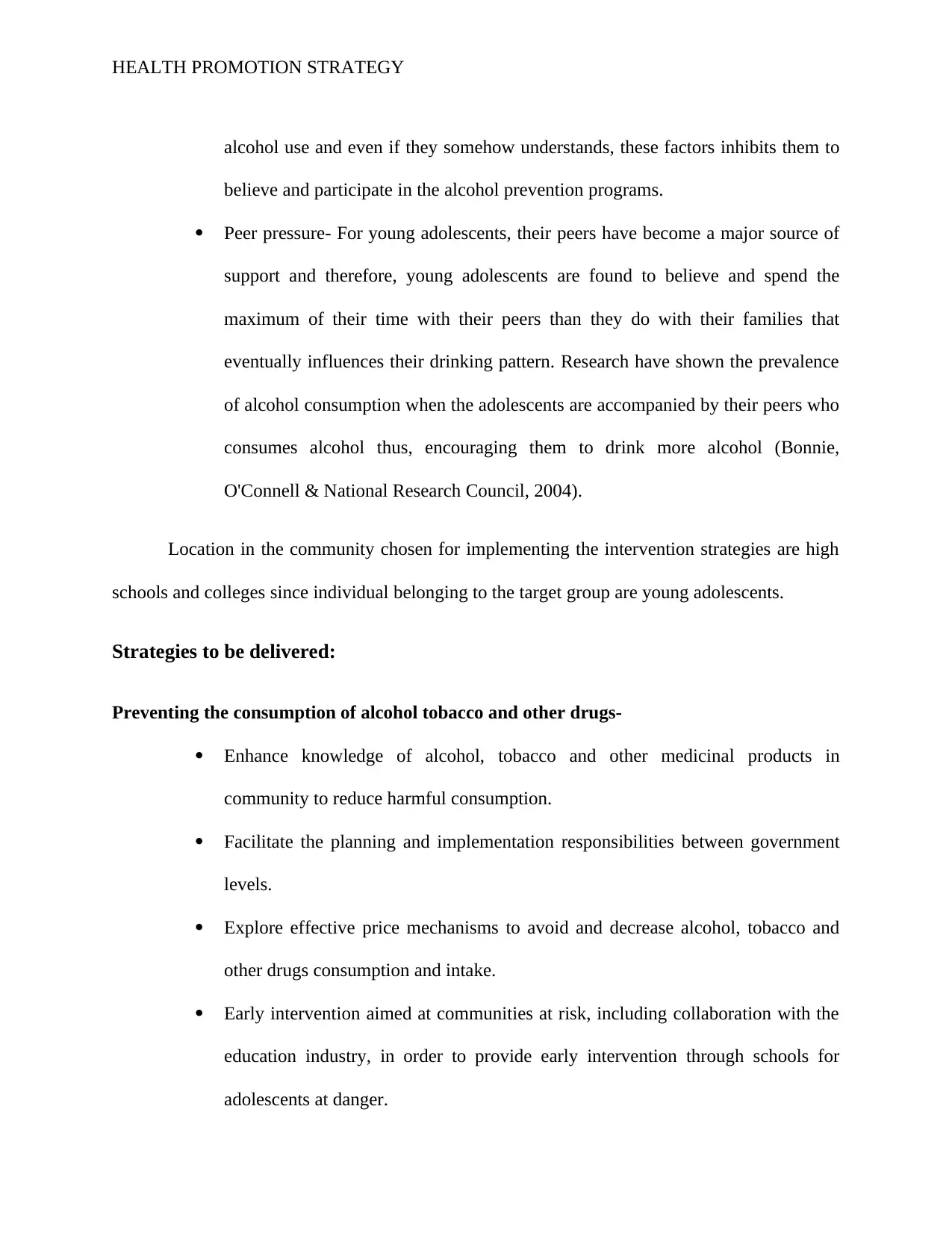
HEALTH PROMOTION STRATEGY
alcohol use and even if they somehow understands, these factors inhibits them to
believe and participate in the alcohol prevention programs.
Peer pressure- For young adolescents, their peers have become a major source of
support and therefore, young adolescents are found to believe and spend the
maximum of their time with their peers than they do with their families that
eventually influences their drinking pattern. Research have shown the prevalence
of alcohol consumption when the adolescents are accompanied by their peers who
consumes alcohol thus, encouraging them to drink more alcohol (Bonnie,
O'Connell & National Research Council, 2004).
Location in the community chosen for implementing the intervention strategies are high
schools and colleges since individual belonging to the target group are young adolescents.
Strategies to be delivered:
Preventing the consumption of alcohol tobacco and other drugs-
Enhance knowledge of alcohol, tobacco and other medicinal products in
community to reduce harmful consumption.
Facilitate the planning and implementation responsibilities between government
levels.
Explore effective price mechanisms to avoid and decrease alcohol, tobacco and
other drugs consumption and intake.
Early intervention aimed at communities at risk, including collaboration with the
education industry, in order to provide early intervention through schools for
adolescents at danger.
alcohol use and even if they somehow understands, these factors inhibits them to
believe and participate in the alcohol prevention programs.
Peer pressure- For young adolescents, their peers have become a major source of
support and therefore, young adolescents are found to believe and spend the
maximum of their time with their peers than they do with their families that
eventually influences their drinking pattern. Research have shown the prevalence
of alcohol consumption when the adolescents are accompanied by their peers who
consumes alcohol thus, encouraging them to drink more alcohol (Bonnie,
O'Connell & National Research Council, 2004).
Location in the community chosen for implementing the intervention strategies are high
schools and colleges since individual belonging to the target group are young adolescents.
Strategies to be delivered:
Preventing the consumption of alcohol tobacco and other drugs-
Enhance knowledge of alcohol, tobacco and other medicinal products in
community to reduce harmful consumption.
Facilitate the planning and implementation responsibilities between government
levels.
Explore effective price mechanisms to avoid and decrease alcohol, tobacco and
other drugs consumption and intake.
Early intervention aimed at communities at risk, including collaboration with the
education industry, in order to provide early intervention through schools for
adolescents at danger.

HEALTH PROMOTION STRATEGY
Supporting community engagement and responding to alcohol, tobacco and other drug
use-
Prevention programs that supports organizations and clubs at community level.
Campaigns and awareness programs related to the harmful effects of alcohol and
other substances.
Developing and promoting culturally appropriate information on alcohol, tobacco
and other drugs and also resources to support individuals, families, communities
and professionals who come into contact with people at an increasing risk of
alcohol, tobacco and other drugs.
Strengthening and enhancing local community’s relationships to avoid and
decrease harm associated with alcohol, tobacco, and other drugs.
Developing, implementing and evaluating community and stakeholder
engagement processes as portion of strategy and programme-building.
Reducing the adverse health, social and economic consequences of alcohol consumption-
Implementing settings based approaches for modifying the risk behaviors and providing
opportunity for intervention among those groups who are at a high risk.
Awareness programs should be held for the reduction of alcohol, tobacco and other drugs
during the time of high risk, for example, pregnancy.
Enhancingsystems for facilitating a greater diversion into health interventions from
criminal justice system for the risk populations, especially, young people, Aboriginals
and Torres Strait Islander people, and others who are at risk.
Supporting community engagement and responding to alcohol, tobacco and other drug
use-
Prevention programs that supports organizations and clubs at community level.
Campaigns and awareness programs related to the harmful effects of alcohol and
other substances.
Developing and promoting culturally appropriate information on alcohol, tobacco
and other drugs and also resources to support individuals, families, communities
and professionals who come into contact with people at an increasing risk of
alcohol, tobacco and other drugs.
Strengthening and enhancing local community’s relationships to avoid and
decrease harm associated with alcohol, tobacco, and other drugs.
Developing, implementing and evaluating community and stakeholder
engagement processes as portion of strategy and programme-building.
Reducing the adverse health, social and economic consequences of alcohol consumption-
Implementing settings based approaches for modifying the risk behaviors and providing
opportunity for intervention among those groups who are at a high risk.
Awareness programs should be held for the reduction of alcohol, tobacco and other drugs
during the time of high risk, for example, pregnancy.
Enhancingsystems for facilitating a greater diversion into health interventions from
criminal justice system for the risk populations, especially, young people, Aboriginals
and Torres Strait Islander people, and others who are at risk.
⊘ This is a preview!⊘
Do you want full access?
Subscribe today to unlock all pages.

Trusted by 1+ million students worldwide
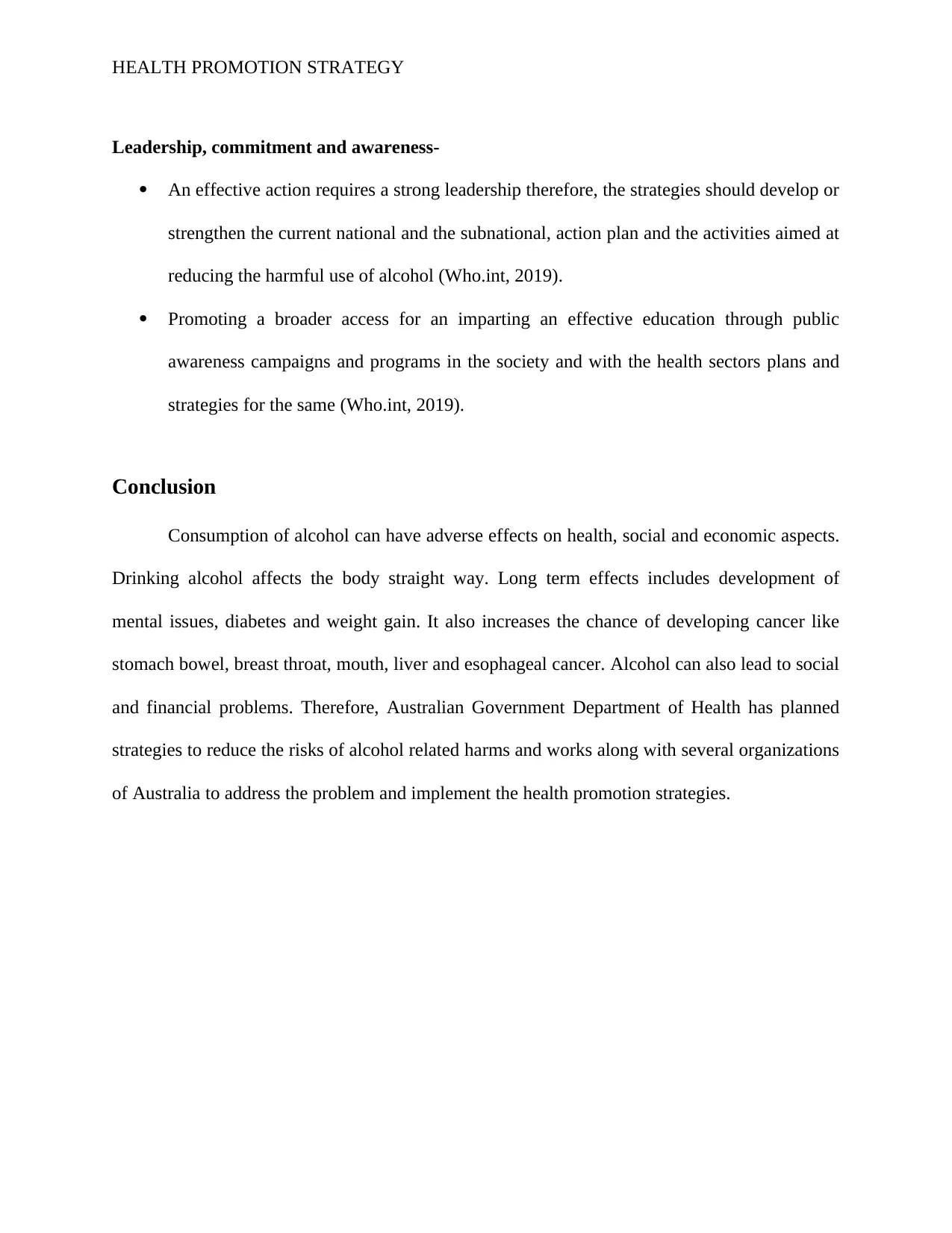
HEALTH PROMOTION STRATEGY
Leadership, commitment and awareness-
An effective action requires a strong leadership therefore, the strategies should develop or
strengthen the current national and the subnational, action plan and the activities aimed at
reducing the harmful use of alcohol (Who.int, 2019).
Promoting a broader access for an imparting an effective education through public
awareness campaigns and programs in the society and with the health sectors plans and
strategies for the same (Who.int, 2019).
Conclusion
Consumption of alcohol can have adverse effects on health, social and economic aspects.
Drinking alcohol affects the body straight way. Long term effects includes development of
mental issues, diabetes and weight gain. It also increases the chance of developing cancer like
stomach bowel, breast throat, mouth, liver and esophageal cancer. Alcohol can also lead to social
and financial problems. Therefore, Australian Government Department of Health has planned
strategies to reduce the risks of alcohol related harms and works along with several organizations
of Australia to address the problem and implement the health promotion strategies.
Leadership, commitment and awareness-
An effective action requires a strong leadership therefore, the strategies should develop or
strengthen the current national and the subnational, action plan and the activities aimed at
reducing the harmful use of alcohol (Who.int, 2019).
Promoting a broader access for an imparting an effective education through public
awareness campaigns and programs in the society and with the health sectors plans and
strategies for the same (Who.int, 2019).
Conclusion
Consumption of alcohol can have adverse effects on health, social and economic aspects.
Drinking alcohol affects the body straight way. Long term effects includes development of
mental issues, diabetes and weight gain. It also increases the chance of developing cancer like
stomach bowel, breast throat, mouth, liver and esophageal cancer. Alcohol can also lead to social
and financial problems. Therefore, Australian Government Department of Health has planned
strategies to reduce the risks of alcohol related harms and works along with several organizations
of Australia to address the problem and implement the health promotion strategies.
Paraphrase This Document
Need a fresh take? Get an instant paraphrase of this document with our AI Paraphraser
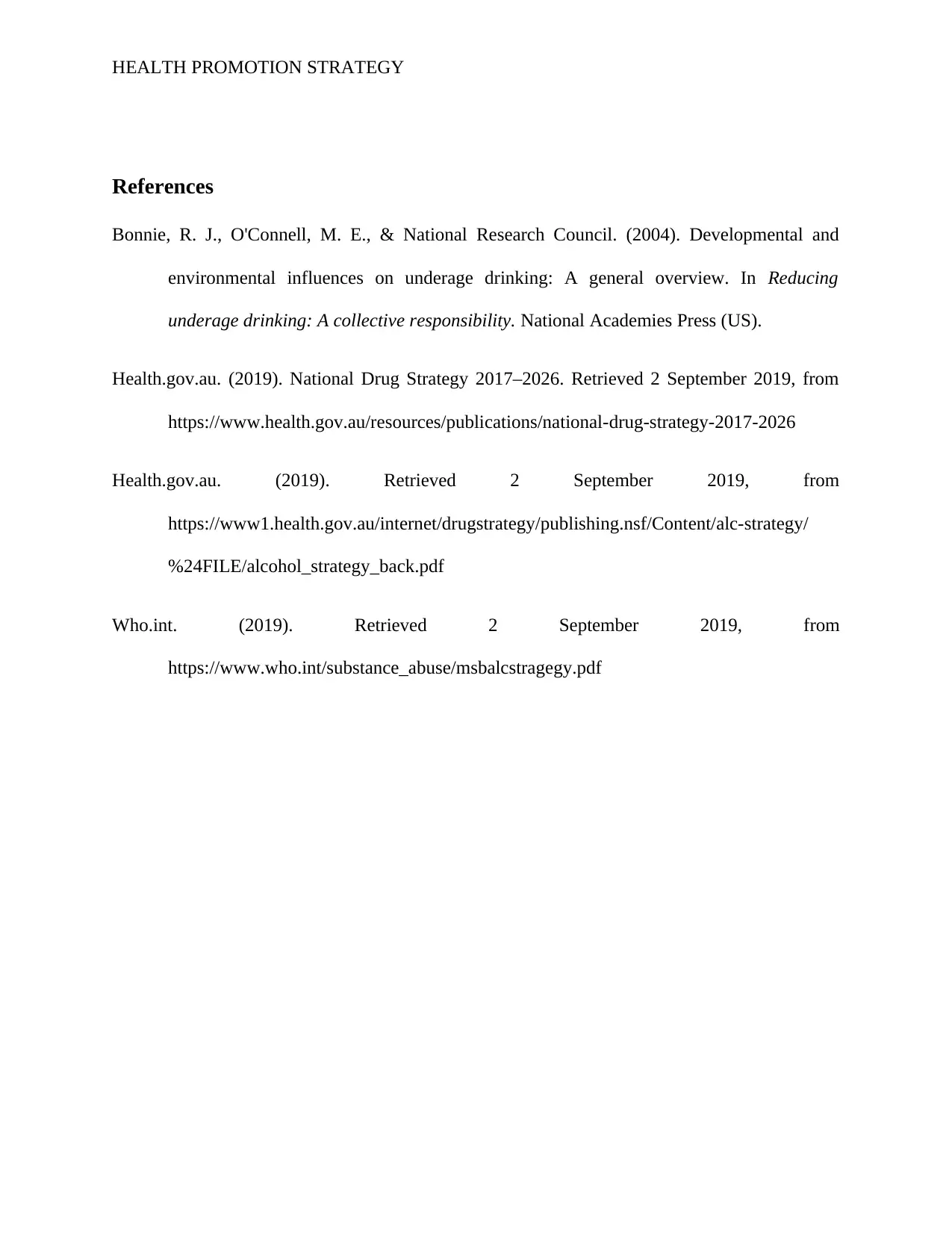
HEALTH PROMOTION STRATEGY
References
Bonnie, R. J., O'Connell, M. E., & National Research Council. (2004). Developmental and
environmental influences on underage drinking: A general overview. In Reducing
underage drinking: A collective responsibility. National Academies Press (US).
Health.gov.au. (2019). National Drug Strategy 2017–2026. Retrieved 2 September 2019, from
https://www.health.gov.au/resources/publications/national-drug-strategy-2017-2026
Health.gov.au. (2019). Retrieved 2 September 2019, from
https://www1.health.gov.au/internet/drugstrategy/publishing.nsf/Content/alc-strategy/
%24FILE/alcohol_strategy_back.pdf
Who.int. (2019). Retrieved 2 September 2019, from
https://www.who.int/substance_abuse/msbalcstragegy.pdf
References
Bonnie, R. J., O'Connell, M. E., & National Research Council. (2004). Developmental and
environmental influences on underage drinking: A general overview. In Reducing
underage drinking: A collective responsibility. National Academies Press (US).
Health.gov.au. (2019). National Drug Strategy 2017–2026. Retrieved 2 September 2019, from
https://www.health.gov.au/resources/publications/national-drug-strategy-2017-2026
Health.gov.au. (2019). Retrieved 2 September 2019, from
https://www1.health.gov.au/internet/drugstrategy/publishing.nsf/Content/alc-strategy/
%24FILE/alcohol_strategy_back.pdf
Who.int. (2019). Retrieved 2 September 2019, from
https://www.who.int/substance_abuse/msbalcstragegy.pdf
1 out of 8
Related Documents
Your All-in-One AI-Powered Toolkit for Academic Success.
+13062052269
info@desklib.com
Available 24*7 on WhatsApp / Email
![[object Object]](/_next/static/media/star-bottom.7253800d.svg)
Unlock your academic potential
Copyright © 2020–2025 A2Z Services. All Rights Reserved. Developed and managed by ZUCOL.





